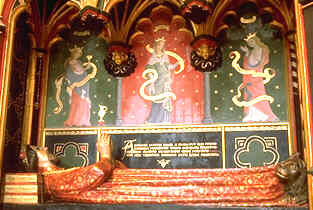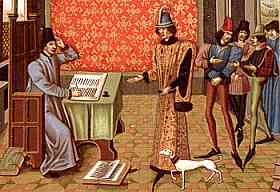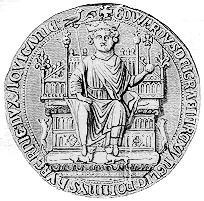 |
| Authors,
Scribes and Libraries |
 |
The
tomb of poet John Gower in Southwark cathedral, London, restored to colourful
medieval splendour, or perhaps something more alarming. |
| The
medieval manuscripts
which survive in libraries and archives today represent two major aspects
of the production of written works; generation and transmission. We can
learn about medieval society by studying both these aspects of manuscript
production. In the industrial mode of production of the written word,
which had its beginnings in the 15th century and may hopefully in the
near future decline into obscurity, these processes are entirely separate.
An author creates a work, then hands a manuscript, a typescript, a floppy
disk or an email attachment to a publisher for transmission and distribution.
At some stage they are sent either a cheque or a notification that their
work has been remaindered and they can buy back copies of their own work
at a cheap price. Things are changing, as this project itself testifies. |
| In
the middle ages, the author of a work was the first step in a long chain
of transmission, in which works were sequentially copied out by hand over
generations and centuries. The original authors established patterns of
thought which were as valued as the fine manuscripts on which they were
recorded. A manuscript which was actually penned by its original author
is known as an autograph
manuscript. In some cases, the original author was also the illustrator
of the manuscript. |
|
| Froissart writing, after a Burgundian manuscript of around 1460 (Bibliothèque de l'Arsenal, ms 5190). |
| When
it comes to books, whether works of literature or works of knowledge,
very few are known from autograph manuscripts. The earliest surviving
copy, particularly of very early works, may post-date its original author
by centuries. The scribes,
and the agencies which employed them, have revealed the values of their
society in the selection of works which they have chosen to perpetuate. |
| The
way in which the scribes worked, and the various forms of script
which they used for particular tasks, reveal a great deal about the attitude
of society to particular forms of written work. Certain types of work
required elaborate and formal scripts which were slow to write, while
others sufficed with rapidly written but less formal cursive
scripts. The significance of a work did not necessarily correlate with
legibility, and tricks of calligraphy
and design could enhance the importance of a work without making it easy
to read at all. |
 |
| Fragment
of a document of the reign of Richard I, with many calligraphic flourishes. |
| Paleographers traditionally like to distinguish between books and documents. There is
some sense in this. Not only did each area develop its specialised families
of scripts, which periodically crossed the border and hybridised, but
there are significant differences in the authoring and production of the
two classes of works. However, I will attempt to run them in parallel
here, because I donít believe in the Humpty Dumpty approach to scholarship,
and because changes in both areas are significant in charting the social
history of reading and writing. |
| Thus
a book generally originally had a single author, or was compiled from the
works of various authors, and was transmitted sequentially by individual
scribes. Errors and variations crept in and were perpetuated through subsequent
generations of the book. Scholars of immense and extraordinary patience
and diligence have actually worked out the pedigrees of these chains of
transcription by
plotting the variant forms, thereby working out routes of contact and communication
delineated by them. The results are fascinating, but the work ... unbelievable! |
| In
the context of medieval documents, the authors can be considered to be
the many corporate agencies embodied within the institutions of the state,
the law, government and the church. Each agency developed particular forms
of document for their special functions. The documents were not copied
in generational sequences, but agencies developed their own writing offices
or chanceries to
author, transcribe and archive these materials. A document issued under
the name of the king was not authored or scripted by him. Mostly he didnít
even sign it, but it was authenticated by seal.
We are dealing with institutional processes here, even when we can identify
the actions and words of individuals within the process. |
|
|
Great
seal of Edward I |
|
Authors |
|
|
|
 |
 |
 |
 |



